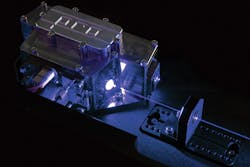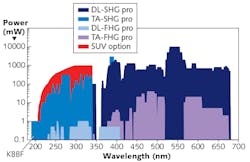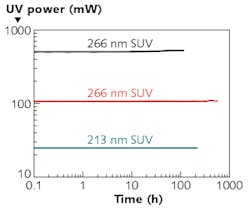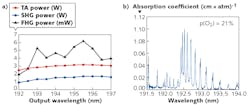Novel Lasers: Short, shorter, shortest - Diode lasers in the deep ultraviolet
ULRICH EISMANN, MATTHIAS SCHOLZ, TIM PAASCH-COLBERG, and JÜRGEN STUHLER
Numerous photonics applications in research and industry require ultraviolet (UV) laser light. Only a few types of conventional laser systems provide UV light, and those emit at fixed wavelengths.
Here, we present the latest developments in diode-based laser systems that produce continuous-wave (CW) tunable UV output, in which digital control electronics allow for improved performance and user-friendliness. Novel frequency-doubling techniques enable higher output powers and stable long-term operation and crystal materials research has helped to overcome classical limitations in nonlinear conversion, enabling frequency-doubled output wavelengths below 193 nm.
New laser sources operating in the deep-ultraviolet (DUV) range (the wavelength region below 300 nm) can help to streamline industrial and scientific applications. For example, state-of-the-art semiconductor lithography and inspection are currently performed using somewhat-expensive pulsed excimer lasers at 193 nm. Actinic inspection of exposed wafers—that is, inspection at the exposure wavelength—can benefit from continuous-wave light sources.
On the scientific side, applications include angle-resolved photoemission spectroscopy (ARPES), where researchers need high photon energies for the measurement of large portions of the Brillouin zone of new materials. Lasers with wavelengths in the range of 170–205 nm with narrowband emission have proven to be most effective. Wavelengths below 200 nm are also required for photoluminescence studies of high-bandgap materials, which are under investigation for building UV LEDs.1 In addition, new applications are emerging in the field of Raman spectroscopy, such as protein structural analysis and Raman spectroscopy beyond the solar background.2
In quantum technology, tunable DUV lasers are used for high-resolution spectroscopy and laser cooling. For instance, atomic clocks can be improved considerably with direct access to optical transitions in aluminum or mercury ions, and one can possibly realize nuclear optical clocks with thorium in the near future.3,4
Short-wavelength diode lasers
Diode lasers are compact and lightweight, very energy-efficient, require little or no maintenance, and are relatively low in cost. Applications in science and research benefit from diode laser technology, particularly where they can rely on improved properties of the emitted light or the tunability. Examples are spectrally narrowed lasers that use an external reflective grating, also known as external-cavity diode lasers (ECDLs). Using this technique, this type of laser by Toptica achieves a free-running linewidth of a few kilohertz, as compared to the several-hundred gigahertz of a diode laser without ECDL technology.
Another advantage of an ECDL is the ability to tune the laser emission wavelength continuously and in a well-controlled fashion without mode-hopping. Conventionally, a mode-hop-free tuning range of 30–50 GHz is achieved, while the coarse tuning reaches several nanometers. Advanced ECDL technology allows scans of even more than 110 nm without mode-hopping.
Finding the perfect match of semiconductor materials and their emission wavelengths to produce reliable and long-lived diode lasers remains a challenge. So far, only the infrared range is accessible quasi-continuously using different semiconductors. For blue and ultraviolet wavelengths, a few materials exist that cover the spectral region containing the 488, 445, 405, and 375 nm wavelengths, the shortest commercially available wavelength being around 370 nm. To this day, it is not possible to generate light in the DUV range with direct-diode laser technology.
Shorter wavelengths via frequency-doubling
An alternative way of extending the wavelength range of diode lasers is second-harmonic generation (SHG) via frequency-doubling of laser light. An efficient frequency-doubling process has a few technical challenges. Besides energy conservation, the momentum-conservation criteria of the three involved photons (two input and one output) have to be met. This requires an identical phase velocity, and therefore an identical refractive index for the photons inside the nonlinear crystal.
Dispersion usually prevents identical refractive indices for different wavelengths, unless particular conditions are created in which the polarizations and propagation directions of the photons, as well as the crystal temperature, are optimized to make the phase velocities identical. This so-called phase-matching requires nonlinear crystals that are cut at specific angles—in addition, one needs a mechanically stable but adjustable mount and temperature stabilization.
Because of its nonlinear character, the SHG process requires plenty of fundamental laser power. Recycling of the remaining initial light after its passage through the nonlinear crystal by enclosing the nonlinear crystal with a resonant optical cavity can increase the frequency-doubling efficiency by orders of magnitude. Interferometric power buildup is only achieved if the laser linewidth is significantly below the cavity linewidth of a few megahertz. State-of-the-art ECDLs fulfill this criterion easily, and their output power can be amplified using semiconductor tapered amplifiers (TAs), making them ideal candidates for fundamental sources in frequency-converted laser systems.
To maintain resonant operation, the optical path length of the cavity has to be an integer multiple of the fundamental laser wavelength. This is achieved by regulating it with piezo actuators in a control loop. For the error-signal generation, Toptica SHG systems use the Pound-Drever-Hall method, since it is the fastest and the most reliable technique. The control signal is processed digitally, while a two-piezo actuator scheme provides a large amplitude for slow variations or wavelength scans, as well as a high bandwidth of about 30 kHz to compensate for acoustic noise and vibrations.
Steady improvements of the essential optical semiconductor materials such as those for TA chips, and of the frequency-doubling technology, have led to an increase of the available output power of frequency-doubled diode laser systems (see Fig. 1). Currently, more than 2 W of output power are available in the visible range and for near-UV wavelengths.5 In addition, many spectral gaps in these areas have recently been filled. Examples include the region around 400 nm (cooling of ytterbium and calcium ions), 461 nm (cooling of strontium), 480 nm (Rydberg excitations of rubidium), 556 nm (ytterbium laser cooling), 589 nm (sodium laser cooling), and 671 nm (lithium laser cooling).Noise in the fundamental-frequency laser light of Toptica's frequency-doubled and -quadrupled diode lasers is minimized via digital control of the laser systems. The low frequency-noise level of the fundamental laser light is transferred to the frequency-converted light.
Even shorter-deep-UV challenges
To generate laser light with even-shorter wavelengths in the DUV range, the output of the first SHG stage can be frequency-doubled again in a second SHG stage. Such a double-SHG laser is usually dubbed a fourth-harmonic generation (FHG) system. Additional technical challenges occur in the DUV range, such as increased absorption by the optical materials, which can cause degradation of output power levels. This can be avoided by sealing all optical, mechanical, and electrical feedthroughs, resulting in a residual leak rate of 10-3–10-5 mbar l/s (see image at the top of this page). By design, all included mirrors and the nonlinear crystal can be accessed and aligned without opening the cavity.
With this technology, 300 mW output at wavelengths longer than 300 nm are easily achieved. At 243 nm and 254 nm—two wavelengths required for spectroscopy of hydrogen or mercury—an output power of 60 mW is feasible. Also, at the mercury wavelength, several milliwatts of output power are available from direct SHG of a green ECDL.6
Even at 230 nm, more than 20 mW are available for the study of indium ions or Rydberg states in lithium. Below 205 nm, nonlinear frequency conversion is not accessible through SHG using conventional crystals, because phase matching is not achieved at such short wavelengths. Nevertheless, the FHG systems reach 1 mW output power at this "classical barrier" of 205 nm.
The relatively modest lifetimes and output powers available from such systems can be overcome using the technology Toptica developed for digitally controlled FHG systems. The results of the corresponding long-term output power stability measurements are shown in Fig. 2. The red curve, taken for 100 mW output power at 266 nm, shows no signs of degradation over more than 500 hours, without any active stabilization.The output power and wavelength range were increased subsequently in the measurement. A fivefold increase in power at 266 nm yielded no visible sign of degradation at 266 nm over more than 110 hours. At 213 nm, the built-in PowerLock function was applied to keep the output power value of 25 mW constant. No degradation over a measurement period of more than 220 hours was observed, with a projected total lifetime exceeding 10,000 hours. At this point, measurements are still ongoing.
Shortest wavelengths from KBBF
Recent developments in crystal research allow phase-matching in the SHG process for wavelengths below 205 nm by using potassium fluoroboratoberyllate (KBBF).7 It has a higher transparency in the UV compared to other nonlinear crystals and also allows phase-matching for wavelengths below 200 nm (see table), the vacuum-UV range (VUV), under specific circumstances.
Because of the platelike growth process, only KBBF crystals grown along the c-axis are available at present, which makes it difficult to cut the crystal at the phase-matching angle (the conversion of light from 386 to 193 nm via SHG requires a phase-matching angle of 56.5°, which exceeds the value for internal total reflection). Therefore, the crystal is coupled between two prisms to make it usable in SHG stages.8
Measurements of a system including such a prism-coupled KBBF crystal, and a fundamental TA-SHG pro laser with 1.6 W power at 386 nm to generate an output power of up to 15 mW at a wavelength of 193 nm are shown in Fig. 3. The output power at wavelengths of 191 nm and 193 nm are presented as a function of the fundamental input power.9,10 The 193 nm system reaches an astonishing peak power of 15 mW in single-frequency operation. The VUV light has a linewidth below 1 MHz and a mode-hop-free frequency tuning range of more than 80 GHz. This enables VUV spectroscopy with highest resolution.The output wavelength can be tuned over a wide range (see Fig. 4), where the optical power of the KBBF system is shown as a function of the wavelength. The tuning has only a small effect on the power of the TA stage at 772 nm and the SHG-stage at 386 nm, whereas the output power of the FHG stage at 193 nm exhibits a larger variation. This is caused by the KBBF inhomogeneity. The spectrum is dominated by absorption of oxygen molecules—the measurement matches the expected value for an oxygen concentration of 21%, corresponding to standard atmospheric conditions.
REFERENCES
1. L. Trinkler and B. Berzina, "Luminescence properties of AlN ceramics and its potential application for solid state dosimetry," InTech, doi:10.5772/18658 (2011).
2. I. K. Lebedev et al., Anal. Bioanal. Chem., 381, 431–437 (2005).
3. T. Rosenband et al., Science, 28, 1808–1812 (2008).
4. See http://www.nuclock.eu.
5. U. Eismann et al., "Active and passive stabilization of a high-power violet frequency-doubled diode laser," CLEO 2016, JTu5A.65 (2016).
6. G. Almog et al., Rev. Sci. Instrum., 86, 3, 033110 (2015).
7. C. Chen et al., J.Appl. Phys., 77, 2268 (1995).
8. J. Lu et al., Opt. Commun., 200, 415 (2001).
9. M. Scholz et al., Opt. Express, 20, 18659 (2012).
10. M. Scholz et al., Appl. Phys. Lett., 103, 051114 (2013).
11. N. Hoghooghi et al., "Frequency comb with Hz level line widths," Proc. ICOLS, 129, Singapore (2015).
12. Y. N. Zhao et al., Opt. Commun., 283, 4696–4700 (2010).
Ulrich Eismann, Matthias Scholz, Tim Paasch-Colberg, and Jürgen Stuhler are all with Toptica, Munich, Germany; e-mail: [email protected]; www.toptica.com.





